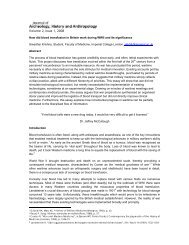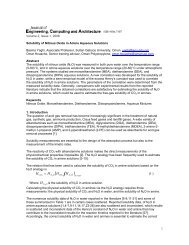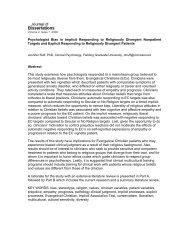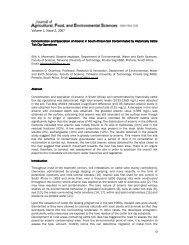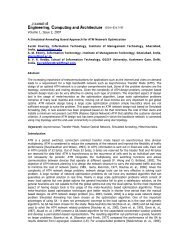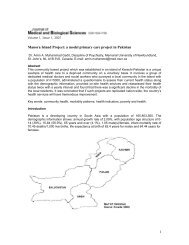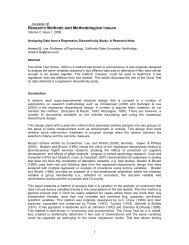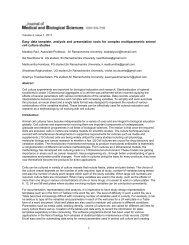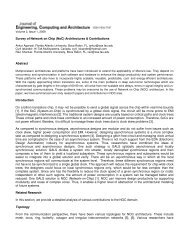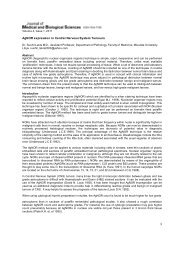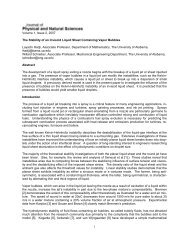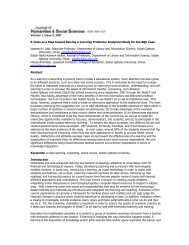The Heaven and Earth Society and the Red Turban Rebellion in ...
The Heaven and Earth Society and the Red Turban Rebellion in ...
The Heaven and Earth Society and the Red Turban Rebellion in ...
Create successful ePaper yourself
Turn your PDF publications into a flip-book with our unique Google optimized e-Paper software.
advanc<strong>in</strong>g on Guangzhou. 186 In sum, <strong>the</strong> contributions by <strong>the</strong>se militias towards <strong>the</strong> suppression of rebellion<br />
<strong>and</strong> polic<strong>in</strong>g of <strong>the</strong> local areas were considerable.<br />
While <strong>the</strong> need to use local forces at a time of emergency was recognized, officials regarded <strong>the</strong><br />
rais<strong>in</strong>g of militia as potentially dangerous. As a consequence <strong>the</strong>re was a difference between <strong>the</strong> concept of<br />
<strong>the</strong> nature of <strong>the</strong> tuanlian held by officials, <strong>and</strong> that held by <strong>the</strong> gentry. For officials <strong>the</strong> tuanlian was an<br />
immobile <strong>and</strong> non-professional force, <strong>the</strong> direction of which should come under <strong>the</strong> district magistrate, who<br />
should also approve <strong>the</strong> immediate leaders. For <strong>the</strong> gentry, <strong>the</strong> tuanlian, unlike <strong>the</strong> baojia, system offered<br />
direct <strong>in</strong>fluence <strong>in</strong> local affairs. 187 At <strong>the</strong> time of <strong>the</strong> <strong>Red</strong> <strong>Turban</strong> <strong>Rebellion</strong>, <strong>the</strong> weakness of <strong>the</strong> government,<br />
revealed on that occasion, allowed <strong>the</strong> gentry to exploit <strong>the</strong>ir potential strength as leaders of <strong>the</strong> rural<br />
community. For <strong>in</strong>stance, hav<strong>in</strong>g such a strong county militia bureau, <strong>the</strong> gentry class <strong>in</strong> Shunde was able to<br />
assert <strong>in</strong> <strong>the</strong> aftermath of <strong>the</strong> <strong>Red</strong> <strong>Turban</strong> <strong>Rebellion</strong>. S<strong>in</strong>ce <strong>the</strong> nearby Xiangshan county was still under <strong>the</strong><br />
threat from <strong>the</strong> <strong>Red</strong> <strong>Turban</strong>s, <strong>the</strong> gentry of Shunde county had <strong>the</strong> excuse to take over control of <strong>the</strong> police<br />
forces of <strong>the</strong> polder farm <strong>in</strong> Xiangshan county, which was known collectively as ‘Donghai Shiliusha<br />
東 海 十 沙 (Sixteen delta l<strong>and</strong>s of <strong>the</strong> Eastern Sea).’ <strong>The</strong> Shunde gentry <strong>the</strong>n asked <strong>the</strong> polder farm owners<br />
to donate 0.6 tales per mow annually as a protection fee. S<strong>in</strong>ce <strong>the</strong>re were 460,000 mows of polder farms <strong>in</strong><br />
Xiangshan county, this meant an annual revenue of 276,000 tales to <strong>the</strong> gentry <strong>in</strong> Shunde county. With such<br />
a strong f<strong>in</strong>ancial base, <strong>the</strong> gentry <strong>in</strong> Shunde county was able to donate huge sums of money to f<strong>in</strong>ance <strong>the</strong><br />
prov<strong>in</strong>cial military. 188<br />
In sum, <strong>the</strong> <strong>Red</strong> <strong>Turban</strong> <strong>Rebellion</strong> had aga<strong>in</strong> realigned <strong>the</strong> power structure of <strong>the</strong> local Ch<strong>in</strong>ese<br />
communities, with <strong>the</strong> gentry emerg<strong>in</strong>g from <strong>the</strong> rural upheavals considerably streng<strong>the</strong>ned. In <strong>the</strong> 1850s,<br />
<strong>the</strong> gentry obta<strong>in</strong>ed <strong>the</strong> legitimacy to reorganize regional militia, to have its own tax base to f<strong>in</strong>ance <strong>the</strong><br />
militia, <strong>and</strong> to use <strong>the</strong> militia for regional hegemony. 189<br />
5) Conclusion<br />
In this paper I have attempted to focus <strong>the</strong> history of <strong>the</strong> Ti<strong>and</strong>ihui <strong>in</strong> Guangdong <strong>in</strong> <strong>the</strong> midn<strong>in</strong>eteenth<br />
century, <strong>the</strong> set of events that led up to <strong>the</strong> <strong>Red</strong> <strong>Turban</strong> <strong>Rebellion</strong>, <strong>and</strong> to describe <strong>the</strong> rebellion<br />
itself. Significantly, this local <strong>in</strong>surgency is easily overshadowed by <strong>the</strong> Taip<strong>in</strong>g <strong>and</strong> Nian—two of <strong>the</strong> largest<br />
rebellions <strong>in</strong> Ch<strong>in</strong>ese history—with which it overlapped <strong>in</strong> time. Never<strong>the</strong>less, for a number of reasons <strong>the</strong><br />
factors giv<strong>in</strong>g rise to it <strong>and</strong> <strong>the</strong> details of its development are of <strong>in</strong>terest.<br />
First, <strong>the</strong> local conditions mid-n<strong>in</strong>eteenth century suggest that <strong>the</strong> level of conflict <strong>in</strong> <strong>the</strong> Pearl River<br />
Delta was high, that outbursts of collective violence were common, <strong>and</strong> that rationales for rebellion were<br />
readily available with<strong>in</strong> Ch<strong>in</strong>ese popular culture. <strong>The</strong> evidence suggests that <strong>the</strong> orig<strong>in</strong> of <strong>the</strong> <strong>Red</strong> <strong>Turban</strong><br />
<strong>Rebellion</strong> owed much <strong>the</strong> special historical circumstances of <strong>the</strong> mid-n<strong>in</strong>eteenth-century Pearl River Delta—<br />
crippl<strong>in</strong>g natural disasters exacerbated by <strong>in</strong>efficient government <strong>and</strong> <strong>in</strong>creased taxes <strong>and</strong> <strong>the</strong> success of<br />
<strong>the</strong> Taip<strong>in</strong>g rebels. Most of <strong>the</strong> rebel groups were spurred to rebellion by a comb<strong>in</strong>ation of economic<br />
conditions <strong>and</strong> government dem<strong>and</strong>s. Not only natural disasters, but also government abuses <strong>and</strong> excessive<br />
186 This was a vital for <strong>the</strong> survival of Guangzhou because it prevented Chen Kai jo<strong>in</strong><strong>in</strong>g forces with <strong>the</strong><br />
rebels besieg<strong>in</strong>g <strong>the</strong> city. See F.O. 931.1455. Report from three leaders of <strong>the</strong> gentry on campaign aga<strong>in</strong>st<br />
rebels near Foshan (Aug. 1854).<br />
187 Philip Kuhn, “<strong>The</strong> T’uan-lien Local Defense System at <strong>the</strong> time of <strong>the</strong> Taip<strong>in</strong>g <strong>Rebellion</strong>,” Harvard<br />
Journal of Asiatic Studies 27 (1967).<br />
188 Ano<strong>the</strong>r source of revenue for <strong>the</strong> gentry class was lij<strong>in</strong> 厘 金 -namely, transit tolls levied on articles of<br />
commerce. Each subdivision (called gongyue 公 約 ) of <strong>the</strong> Shunde Central Militia Bureau was functionally<br />
charged with <strong>the</strong> management of funds <strong>in</strong> conjunction with <strong>the</strong> hir<strong>in</strong>g of militia, <strong>the</strong> distribution of relief,<br />
<strong>and</strong> <strong>the</strong> reconstruction of local schools. <strong>The</strong> subdivision obta<strong>in</strong>ed those funds by erect<strong>in</strong>g customer barriers<br />
around major market towns. For <strong>in</strong>stance, <strong>the</strong> Longjiang gongyue 龍 江 公 約 , which had 100 braves <strong>and</strong> an<br />
annual expenditure of 10,000 derived its revenue by collect<strong>in</strong>g donations from <strong>the</strong> cocoon, butcher, <strong>and</strong><br />
mulberry activities. See Shunde Xianzhi 3.2-11, Xiangshan Xianzhi, 1920 16.5-7.<br />
189 It may be noted that <strong>the</strong> old rul<strong>in</strong>g class was not necessarily weakened dur<strong>in</strong>g <strong>the</strong> process of <strong>the</strong><br />
rebellions. It might streng<strong>the</strong>n itself <strong>and</strong> even engage <strong>in</strong> regional hegemony. Fac<strong>in</strong>g <strong>the</strong> crippled state of <strong>the</strong><br />
peasantry <strong>and</strong> <strong>the</strong> state, <strong>the</strong> gentry was able to accumulate massive property right after <strong>the</strong> rebellion. For<br />
example, <strong>in</strong> just a few years after <strong>the</strong> rebellion, 8,641 mows of communal l<strong>and</strong> were acquired to build a<br />
new educational <strong>in</strong>stitution called Q<strong>in</strong>gyun Wenshi 靑 雲 文 社 (Blue Cloud Academy). See Shunde Xianzhi<br />
4.34-36.<br />
28



